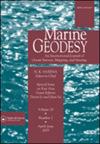Extracting Coastal Water Depths from Multi-Temporal Sentinel-2 Images Using Convolutional Neural Networks
IF 1.4
4区 地球科学
Q2 GEOCHEMISTRY & GEOPHYSICS
引用次数: 4
Abstract
Abstract Satellite-Derived Bathymetry (SDB) can be calculated using analytical or empirical approaches. Analytical approaches require several water properties and assumptions, which might not be known. Empirical approaches rely on the linear relationship between reflectances and in-situ depths, but the relationship may not be entirely linear due to bottom type variation, water column effect, and noise. Machine learning approaches have been used to address nonlinearity, but those treat pixels independently, while adjacent pixels are spatially correlated in depth. Convolutional Neural Networks (CNN) can detect this characteristic of the local connectivity. Therefore, this paper conducts a study of SDB using CNN and compares the accuracies between different areas and different amounts of training data, i.e., single and multi-temporal images. Furthermore, this paper discusses the accuracies of SDB when a pre-trained CNN model from one or a combination of multiple locations is applied to a new location. The results show that the accuracy of SDB using the CNN method outperforms existing works with other methods. Multi-temporal images enhance the variety in the training data and improve the CNN accuracy. SDB computation using the pre-trained model shows several limitations at particular depths or when water conditions differ.基于卷积神经网络的多时相Sentinel-2图像海岸水深提取
摘要卫星测深(SDB)可以使用分析或经验方法进行计算。分析方法需要几种水的性质和假设,而这些可能是未知的。经验方法依赖于反射率和原位深度之间的线性关系,但由于底部类型变化、水柱效应和噪声,这种关系可能不完全是线性的。机器学习方法已被用于解决非线性问题,但这些方法独立处理像素,而相邻像素在深度上是空间相关的。卷积神经网络(CNN)可以检测这种局部连通性的特征。因此,本文使用CNN对SDB进行了研究,并比较了不同区域和不同训练数据量(即单时间图像和多时相图像)之间的精度。此外,本文还讨论了当将来自一个或多个位置的组合的预先训练的CNN模型应用于新位置时,SDB的准确性。结果表明,使用CNN方法的SDB的准确性优于现有的其他方法。多时相图像增强了训练数据的多样性,提高了CNN的准确性。使用预训练模型的SDB计算显示了在特定深度或水条件不同时的几个限制。
本文章由计算机程序翻译,如有差异,请以英文原文为准。
求助全文
约1分钟内获得全文
求助全文
来源期刊

Marine Geodesy
地学-地球化学与地球物理
CiteScore
4.10
自引率
6.20%
发文量
27
审稿时长
>12 weeks
期刊介绍:
The aim of Marine Geodesy is to stimulate progress in ocean surveys, mapping, and remote sensing by promoting problem-oriented research in the marine and coastal environment.
The journal will consider articles on the following topics:
topography and mapping;
satellite altimetry;
bathymetry;
positioning;
precise navigation;
boundary demarcation and determination;
tsunamis;
plate/tectonics;
geoid determination;
hydrographic and oceanographic observations;
acoustics and space instrumentation;
ground truth;
system calibration and validation;
geographic information systems.
 求助内容:
求助内容: 应助结果提醒方式:
应助结果提醒方式:


